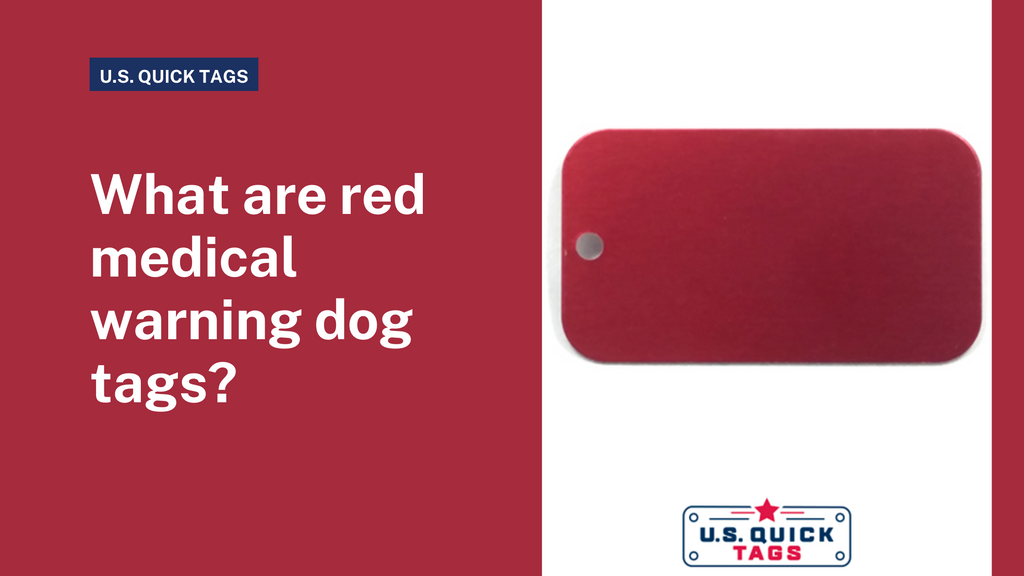What Are Red Medical Warning Dog Tags?
- USQuickBlogs
- 12 Oct, 2021
In the military, dog tags have been used for generations as a form of identification. The origins of dog tags have roots in the Civil War, but they weren't officially used until 1899. The primary purpose of these tags was to identify fallen soldiers - or those left on the battlefield that were severely injured. While originally in a disc shape, they evolved in World War II to become the rounded rectangular shape we now know today.
A lot of information is placed on these small tags, but what a lot of people don't know is there are different variants of the traditional dog tag. When you think of army dog tags, your mind instantly conjures up an image of the traditional silver tags. These are widely used and issued to every member of the military, but there are also different colored tags in circulation - such as red dog tags.
In this guide, you will learn all there is to know about red dog tags, including what they are and why they are commonly used.
What is a red dog tag?

A red dog tag is a dog tag that's been colored red to symbolize that the wearer has an underlying medical condition. For this reason, they are often called red medical warning dog tags. They are the same design and shape as normal dog tags, but with a different purpose. Primarily, their sole aim is to alert other military personnel that someone has a medical condition that requires special attention.
Why are red medical warning dog tags used?
As mentioned above, their purpose is to notify others of a potential medical condition. However, they can also be used to display if a soldier has a particular allergy.
Why is all of this important?

In essence, red dog tags are used in the same manner as regular ones. They are essential when soldiers have been injured in battle and need to be treated by the medical team. In many scenarios, military personnel that has been injured may be incapacitated. This means they're unable to provide the doctors and medical team with critical information that might impact the treatment they're about to receive. The red medical warning dog tag is instantly spotted by the medics, and they can read the information on it, understanding what medical conditions the person may have.
For instance, someone might have an allergy to particular pain medication, like ibuprofen. In this case, the medics can see this on their tag and look for an alternative medication - if required. It prevents instances where lives could sadly be lost due to a lack of information. Without a red dog tag, the medic might give the fallen soldier something they're allergic to, which could cause a reaction that sadly kills them.
The same goes for any other medical condition a soldier might have. The medics can see it on the dog tag and provide the right treatment based on the information they have. It is simply the easiest and quickest way of obtaining vital medical information when someone is unable to provide the information themselves. It is much faster than looking at a soldier's dog tags, finding their name and service number, then looking up their medical records.
Time is precious in these situations, and the difference between a few seconds and minutes can be the difference between someone making a full recovery and experiencing medical complications.
Do red medical warning dog tags replace regular dog tags?
To put this another way; how does someone wear red dog tags? Contrary to what you might believe, these tags do not replace the regular ones that are issued to every recruit. You will still wear the normal silver dog tags as they provide the essential information displayed below:
- Surname, First Name, Second Initial
- Army Serial Number
- Tetanus Immunization, Tetanus Toxoid, Blood Type
- Religion
The actual information and layout of a US army dog tag have evolved over the years, but this is how they are currently set up. So, what does a medical warning dog tag display, and how is it worn?
Effectively, it will display any medical conditions that require extra attention or deserve to be noted down. We've already mentioned allergies a few times, as these are the most common conditions people have red dog tags for. These tags are then worn alongside the traditional silver ones. So, you have all the information of the regular tags, plus the red one with extra medical info that medics may need to know.
The idea behind this is that the red color makes them really easy for people to spot. You can see right away that this soldier has a medical condition, meaning the medics will react faster to get them the right treatment they need.
Who qualifies for these dog tags?

Not everyone with a medical condition will be issued a red medical warning dog tag. Instead, these tags are primarily reserved for individuals with allergies to any of the following:
- Drugs
- Insects
- Medication
They are also given to people that are G6DP deficiency, and certain serious medical conditions will also warrant one - like heart disease and diabetes. The US army themselves will determine if a red dog tag is necessary or not. For further context, they typically define medical conditions that warrant a red tag as any that are permanent in nature, well established with a defined diagnosis, and critical enough that a lack of knowledge of the condition could cause compromised medical care.
When were red medical warning dog tags first introduced?

These particular dog tags were first issued in 1968 amongst the USMC. Here, they were originally referred to as a USMC Boot Tag, given that they were laced into the left boot laces and tucked into the leather flap.
Nowadays, they can be worn alongside normal dog tags however the wearer likes. Interestingly, despite being in circulation since the late sixties, some branches of the US Army only started introducing them in the mid-2000s.
That's all there is to know about red medical warning dog tags. They are used to help identify medical conditions that injured soldiers might have and are worn alongside the regular dog tags the army will issue.
Choosing the Right Material for Red Medical Tags
When it comes to choosing the right material for red medical tags, two critical factors need consideration: durability and visibility during emergencies. These tags serve as life-saving identifiers in high-stress situations, such as accidents or natural disasters, where quick medical attention is crucial. Optimal materials for these tags should be robust and able to withstand harsh conditions to ensure they remain intact.
Durability is essential to prevent the tag from getting damaged or torn, as it might render crucial information unreadable. Moreover, medical tags must remain legible over time, so medical personnel can access pertinent details like allergies, medical conditions, and emergency contacts without any ambiguity.
Visibility is equally vital, especially in low-light conditions or when medical responders are under time constraints. Bright red tags with clear, bold lettering enhance visibility, making them easily noticeable and identifiable amidst the chaos.
Selecting the right material for red medical tags can significantly impact the effectiveness of emergency response efforts, aiding medical professionals in providing timely and appropriate care to those in need.
Customizing Red Medical Warning Tags
Customizing red medical warning tags involves careful consideration of engraving guidelines to ensure clear and concise information is conveyed. These tags are essential for communicating critical medical details, allergies, and emergency contacts during emergencies, making engraving crucial.
Firstly, it is essential to prioritize relevant information that needs to be included in the tag. Vital details such as the person's name, specific medical conditions, medications, and allergies should be prominently engraved. Additionally, emergency contact information must be easily accessible to medical professionals.
To maintain clarity, concise language, and abbreviations should be used appropriately. Unnecessary jargon or complex medical terms may lead to misunderstandings during high-pressure situations.
Choosing the right font size and style is crucial to enhance legibility. A clear and bold font ensures that the information can be quickly and accurately read, even in dimly lit or stressful environments.
Regularly reviewing and updating the information on the tag is important, especially if there are any changes in the person's medical status or contact details.
Caring for Red Medical Dog Tags
Caring for red medical dog tags is essential to ensure their legibility and overall condition, maximizing their effectiveness in emergencies. Here are some maintenance tips for preserving these tags:
Regular Cleaning: Clean the dog tags regularly with mild soap and water to remove dirt, grime, or any substances that might obscure the engraved information. Avoid using harsh chemicals or abrasive materials that could damage the tag's surface.
Avoiding Excessive Wear: While dog tags are meant to be durable, excessive wear, especially in rough or abrasive environments, can cause the engravings to fade over time. Be mindful of your dog's activities and try to minimize unnecessary wear and tear.
Protect from Harsh Elements: If you spend a lot of time outdoors or in wet conditions, consider using a protective tag cover or pouch to shield the tag from moisture, mud, and other elements that could affect its legibility.
Regular Information Review: Periodically check the information engraved on the tag to ensure it's up-to-date. If there are any changes to your dog's medical conditions or contact details, promptly update the tag to reflect the latest information.
Legal and Ethical Considerations for Red Medical Tags
When it comes to using medical alert tags, there are important legal and ethical considerations to bear in mind. Understanding these aspects ensures compliance with regulations and promotes responsible usage:
Legal Compliance: Check local laws and regulations regarding using medical alert tags for pets. Some jurisdictions may have specific requirements or restrictions on the type of information allowed on the tags or the circumstances under which they can be used.
Authorization: Ensure that the pet owner has provided explicit authorization for using medical information on the tag. It is essential to have the owner's consent before disclosing any sensitive details about the pet's health.
Accurate Information: Use only accurate and up-to-date medical information on the tags. Providing false or outdated information could lead to improper treatment or delayed care during emergencies.
Privacy Protection: Respect the privacy of the pet owner and their pet. Avoid displaying excessive information that is not relevant to emergency responders. The tag should only include essential medical details and contact information.
Secure Handling: Safeguard sensitive information and store it securely to prevent unauthorized access. Misusing or mishandling sensitive data can lead to legal repercussions and a breach of trust.
Educating Pet Owners: Educate pet owners about the proper use and importance of medical alert tags. Ensure they understand the tags' purpose and how they can be effective in emergencies.
Proper Disposal: If a medical alert tag is no longer needed or has outdated information, dispose of it responsibly to prevent any potential data misuse.
The impact of red medical warning dog tags
The impact of red medical warning tags on military personnel has been profound, with numerous real-life examples showcasing their life-saving potential. These tags play a crucial role in emergencies, providing vital medical information that can lead to timely and appropriate care.
Soldiers wearing these tags have been quickly identified in the field as having specific medical conditions, allergies, or blood types, enabling medics to administer the appropriate treatment without delay. In combat scenarios, where every second counts, these tags have proven to be crucial in ensuring the best possible outcomes for injured personnel.
Heartwarming stories abound, with instances of soldiers attributing their survival to the information on their medical tags. From allergic reactions to chronic conditions, the tags have enabled fellow soldiers and medical teams to respond swiftly and effectively during high-stress situations.
The impact of red medical warning tags extends beyond the battlefield. During humanitarian missions and natural disasters, these tags have aided in identifying and treating injured military personnel, fostering a higher chance of survival and recovery.
Summary
Red medical tags significantly enhance safety and save lives during emergencies. These tags are designed to provide critical medical information quickly and efficiently.
For pets, red medical warning dog tags have heartwarming stories of successful tag usage, enabling strangers and emergency responders to access crucial medical details, resulting in timely and appropriate care. Similarly, for military personnel, red medical warning tags play a vital role in combat situations, quickly identifying soldiers' medical conditions, allergies, or blood type, ensuring rapid medical attention, and improving survival rates.
The impact extends to humanitarian missions and natural disasters, where the tags aid in identifying and treating injured personnel. Overall, red medical tags serve as life-saving tools, proving their effectiveness in high-stress scenarios and emphasizing the importance of accurate information and compliance with legal and ethical considerations.
FAQ
Why are medical warning tags red?
Red symbolizes urgency and is universally recognized as an alert color, making it ideal for medical tags.
Can I move my medical details to a bracelet or card instead?
Absolutely! Medical information can be displayed in various forms, but dog tags remain one of the most durable and visible options.
What if I don’t have a condition—do I still need one?
Yes! Essential information like blood type or emergency contact can be invaluable during a crisis.






